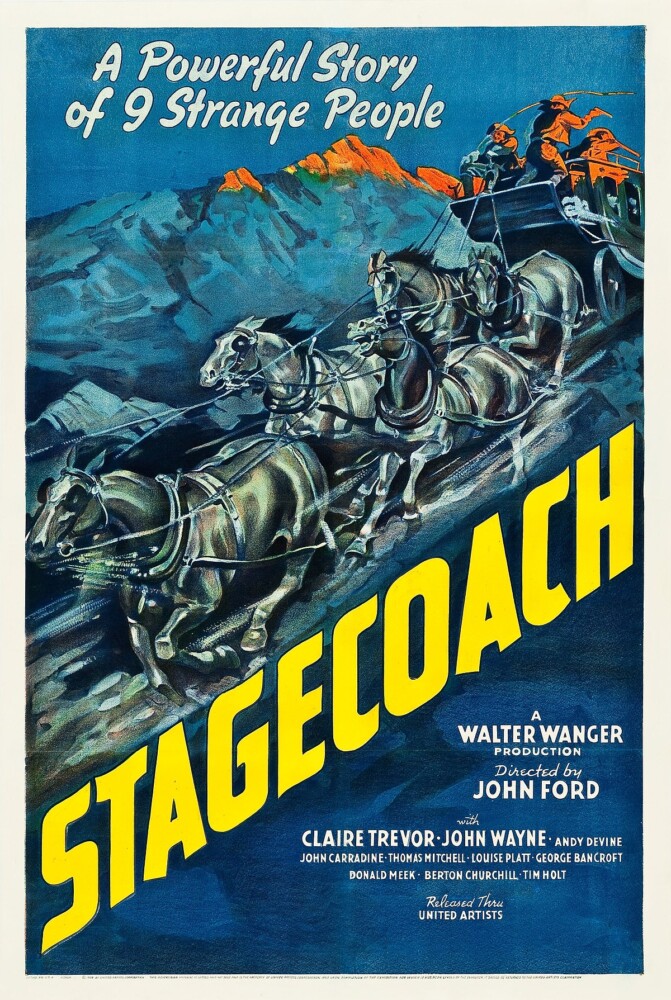by David L. Meister

1939 is widely considered the greatest year for movies, and it’s hard to argue against that. Nine films were nominated for the Best Picture Academy Award: DARK VICTORY, LOVE AFFAIR, MR. SMITH GOES TO WASHINGTON, NINOTCHKA, OF MICE AND MEN, WUTHERING HEIGHTS, THE WIZARD OF OZ, GONE WITH THE WIND, and STAGECOACH. Beyond that, consider these other films that came out that year: GOODBYE MR. CHIPS, BABES IN ARMS, DRUMS ALONG THE MOHAWK, BEAU GESTE, JUAREZ, YOUNG MR. LINCOLN, GUNGA DIN, ONLY ANGELS HAVE WINGS, FOUR FEATHERS, THE PRIVATE LIVES OF ELIZABETH AND ESSEX, and THE HUNCHBACK OF NOTRE DAME.
While GONE WITH THE WIND is both the biggest box office winner of all time (adjusted for inflation), and on Hollywood’s Mt. Rushmore, and THE WIZARD OF OZ is beloved by generation after generation, it was STAGECOACH that represented a unique seismic shift in movie-making.
In 1903, THE GREAT TRAIN ROBBERY was the first “movie” with a narrative. From then on, audiences wanted more than merely the “flickers” of moving images. Movie theater chains competing with one another, bought studios to provide a steady stream of reliable content. In its heyday, MGM, owned by Loew’s, turned out 52 “A” movies a year. But the competition went beyond these marquee films. There were cartoons, newsreels, shorts, and…..another feature. These “B” pictures were typically churned out inexpensively, with emphasis on action. In short, Westerns.
The plots of westerns were repetitive. Good guys caught rustlers, held off marauding Indians, fought in barrooms, and got the girl, usually in an hour or so. The films were fungible; no one went to the movies because of the second film of a double feature. Until February 15, 1939, when John Ford’s STAGECOACH premiered.
United Artists wanted Cary Cooper to star, but Ford insisted on John Wayne, a little-known veteran of 70 “B” westerns. Claire Trevor was the biggest “name” in the cast (playing the prostitute, Dallas), and she received top billing over Wayne, but he catapulted to stardom as The Ringo Kid. In a departure, there wasn’t a lot of the action seen in the typical westerns of the era. Characters were developed instead (in the script which was loosely based on a Guy de Maupassant story), and their arcs drive the film.
Playing those characters were some of the best actors of their day: John Carradine played a Southern Gentleman gambler, dedicated to the safety of Louise Platt, as a pregnant wife anxious to reach her cavalry officer husband. Andy Devine drove the stage, sitting next to George Bancroft, the marshal searching for the fugitive Ringo Kid. Rounding out the passengers were Donald Meek, a booze salesman, and Thomas Mitchell as the drunkard, Doc Boone. Mitchell had a pretty good 1939: he played a newspaperman in MR. SMITH GOES TO WASHINGTON and the O’Hara patriarch in GONE WITH THE WIND, yet it was STAGECOACH that earned him the OSCAR for Best Supporting Actor.
Another OSCAR was won by STAGECOACH, for Best Score (THE WIZARD OF OZ won Best Original Score), while nominations were received for Cinematography, Interior Decoration, Editing, and John Ford’s Direction.
Ford is the most celebrated Director of all time, having won the Academy Award four times, for THE INFORMER, THE GRAPES OF WRATH, HOW GREEN WAS MY VALLEY, and THE QUIET MAN. His 146 films include a slew of silent westerns, before turning out ARROWSMITH, THE WHOLE TOWN’S TALKING, YOUNG MR. LINCOLN, DRUMS ALONG THE MOHAWK, MY DARLING CLEMENTINE, SHE WORE A YELLOW RIBBON, PINKY, MOGAMBO, MISTER ROBERTS, THE SEARCHERS, THE LAST HURRAH, THE MAN WHO SHOT LIBERTY VALANCE, and HOW THE WEST WAS WON. Beyond his incomparable films, Ford is also remembered for standing up to the right-wing Cecil B. de Mille. During the height of the black list, in a contentious meeting of the DGA, Ford allegedly said, “My name’s John Ford. I make Westerns…..and you, Cecil, are a son of a bitch.”
STAGECOACH also introduced audiences to Monument Valley, which served Ford so well in so many of his classics. And Yakima Canutt was featured in the legendary, thrilling, stunt, jumping from the coach to its team of runaway horses, to which Spielberg later paid homage, in RAIDERS OF THE LOST ARK.
Recently, I happened to tune in STAGECOACH in the last 20 minutes. Wayne says “I lied…I have three bullets left”, setting up the climatic gunfight. But that dramatic peak is bracketed by two scenes of Trevor and Wayne, as a pair of outsiders, now fully in love, and committed to one another (as could only happen in a movie). Watching those final few scenes, I was struck by how sweet the film is. It is, above all, a tender romance, where the two leads ride off together. Quite a departure from the traditional western hero riding off into the sunset—alone. And, quite a surprise to me, after many viewings.
After 1939 and STAGECOACH, Hollywood’s biggest names starred in Westerns, some of which are stand among the finest films ever made. HIGH NOON starred Gary Cooper and Grace Kelly; SHANE, Alan Ladd, Jean Arthur and Van Heflin; RED RIVER, Montgomery Clift, and Wayne. Stewart, Fonda, Tracy, Peck, Heston, Bogart, Cagney, Redford, Newman, they all had their day(s) tall in the saddle.
Is STAGECOACH the finest Western ever made? Arguably it’s not even Ford’s best. But it’s great entertainment, and for impact in Hollywood filmmaking, it surely shoots down the rest.

















